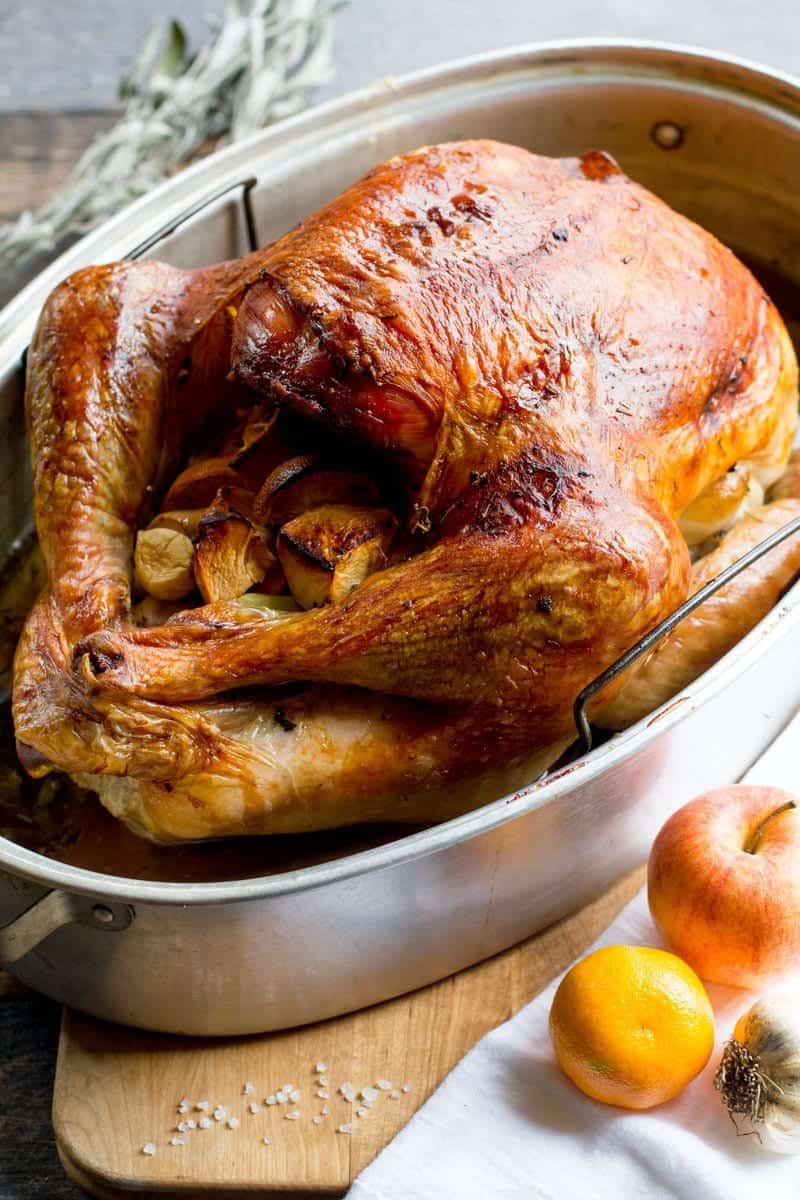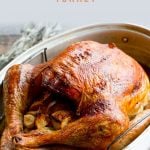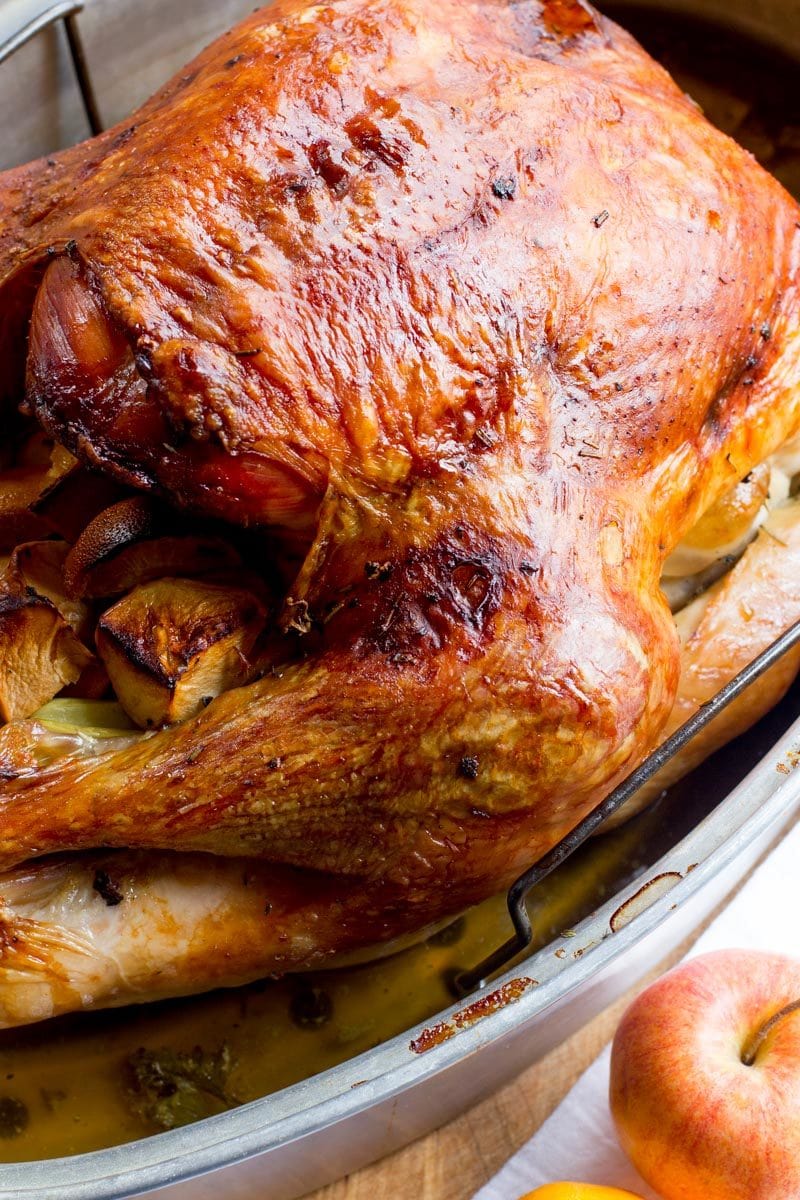Here’s a bold statement for you: if you don’t dry brine your turkey before cooking it this Thanksgiving, you are making a mistake. A big one. Now, I tend to not be very fussy in the kitchen—and I like to skip steps whenever I can—but a turkey brine is one of those steps that you shouldn’t skip.
It sounds like something only fancy TV chefs do, but it really isn’t very complicated at all. In fact, it’s pretty quick and easy with our dry brine recipe! And it makes such a huge difference. It’s like spending $1 to get $100 back. You would do that, wouldn’t you? So then you should totally brine your turkey. That’s just common sense!
If you’re reading this and thinking, “Um, Cass, that’s great, but I don’t even know what brining means,” well, hey! I get that. I didn’t either until a few years back. Let’s dive into everything you need to know about dry brine.
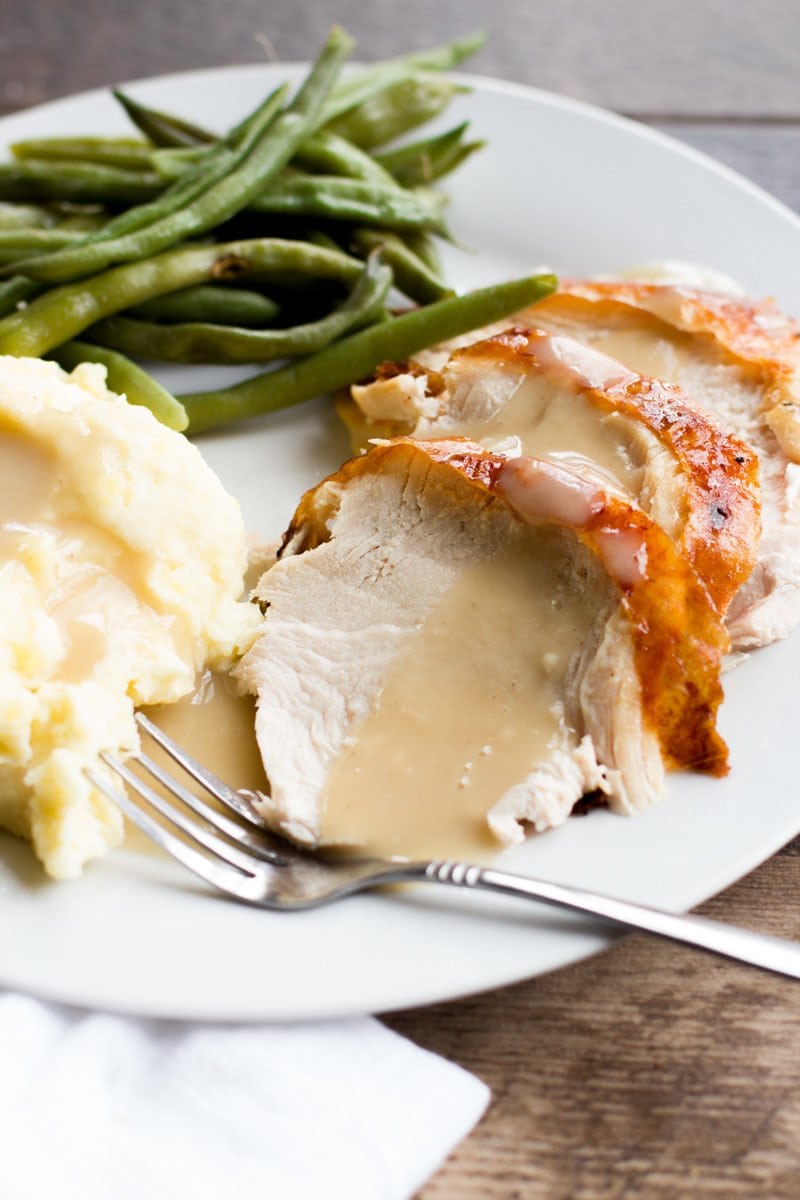
What is a turkey brine and why should I use it?
Brining is treating poultry with salt before cooking to help retain moisture and flavor. There are two kinds of brining—wet and dry. The brine absorbs into the meat, and the moisture is retained when cooking—making the bird more tender and moist.
What’s the difference between a wet brine and a dry brine?
As we said above, there are two kinds of brining, wet and dry, so let’s talk about the differences:
- Wet turkey brine: You dissolve salt and aromatic herbs in a large vat of water (most folks use coolers or five-gallon buckets), and soak your turkey before cooking. The salt, herbs, and water soak into the bird, adding flavor and moisture.
- Dry turkey brine: Dry brining is the same idea, but without the water. Instead, you coat the bird in a salt and herb mixture. The salt soaks into the turkey and lets the natural moisture of the meat stay in your final product.
Wholefully Protip
Cooking for a large crowd? If you have the oven space, you’ll get better moisture and flavor if you cook two smaller turkeys instead of one giant one.
Is it better to wet brine or dry brine a turkey?
I’m 100% in the dry brine camp (although I do I think that wet brining a turkey is better than no brine at all). Why am I Team Dry Brine? Two major reasons:
- Ease: Dry brining a turkey is unquestionably easier and less messy than a wet brine. To wet brine, you have to figure out how to not only submerge a large turkey in gallons water for a few days, but also keep the whole setup cold. For a dry brine, you just sprinkle the mixture on the bird and….that’s it!
- Dry brine actually works BETTER: Yup! The Serious Eats Food Lab did a great deep dive on this, and the gist is that while both dry and wet brine add flavor and moisture to a bird, the moisture that wet brining is adding is mostly flavorless—it’s the water you are soaking it in. Meanwhile, the dry brine encourages the turkey to produce its own juices, which are way more flavorful than boring salted water. Add in the fact that dry brining is also more simple, less messy, and easier? It’s a win for everyone.
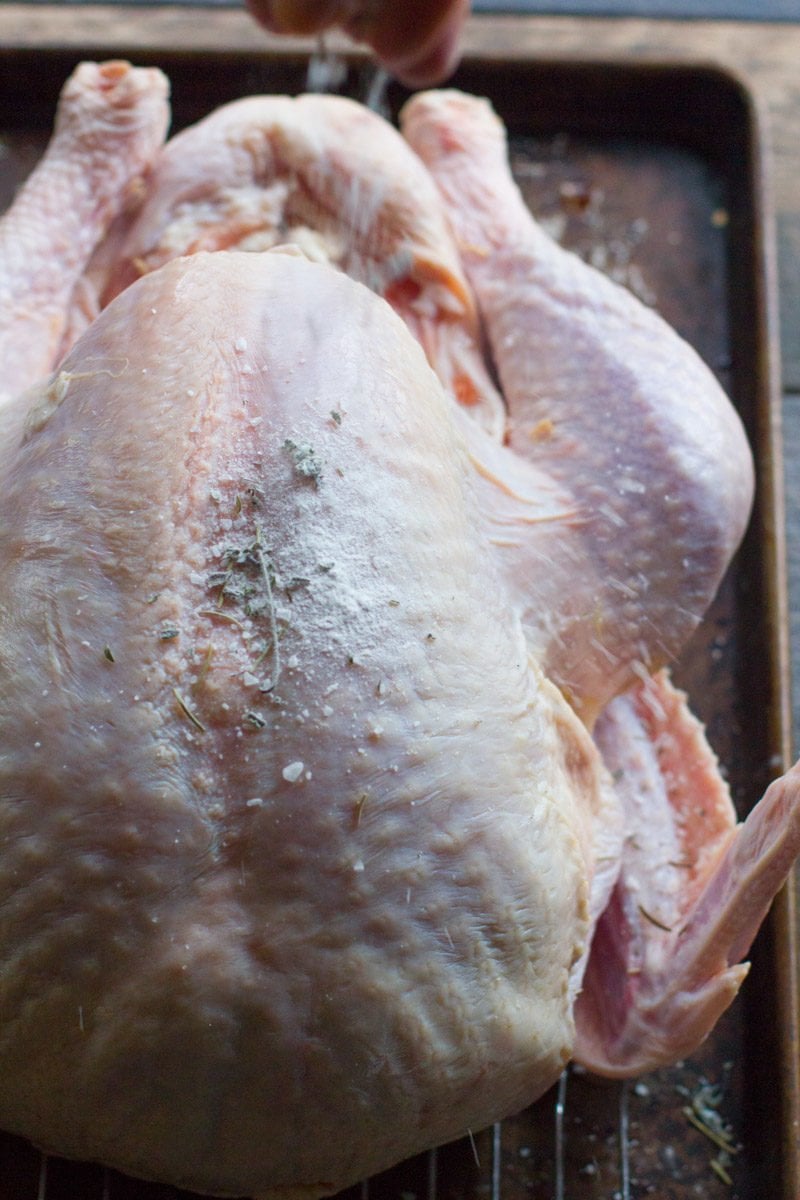
How much salt do I need to dry brine a turkey?
Our recipe depends on how many pounds your turkey is. So for every five pounds of turkey, we recommend:
- 1 tablespoon kosher salt—It must be kosher salt. Any other kind of salt will make your end turkey too salty
- 1 teaspoon baking powder—Not strictly necessary, but baking powder works to break down the proteins in the skin, helping it get golden brown and crispy. It is what makes your turkey look magazine-worthy!
- Dried or fresh minced herbs—Sage, rosemary, parsley, or thyme all work well here. You’ll want 2 teaspoons of dried herbs total, or 2 tablespoons of fresh minced herbs.
Wholefully Protip
Fresh herbs give you the most flavor in a dry brine, but for most of us, fresh herbs aren’t in season during prime turkey season. In that case, dried herbs (or a combination of the two) will do just fine.
Does dry brining make the turkey salty?
Nope! The salt is absorbed nicely into the meat and distributed throughout the bird. Just make sure not to use any added salt if your turkey recipe calls for it.
Okay, great, so how do I dry brine a turkey?
The process is so simple, you’re going to be blown away. Here are the steps:
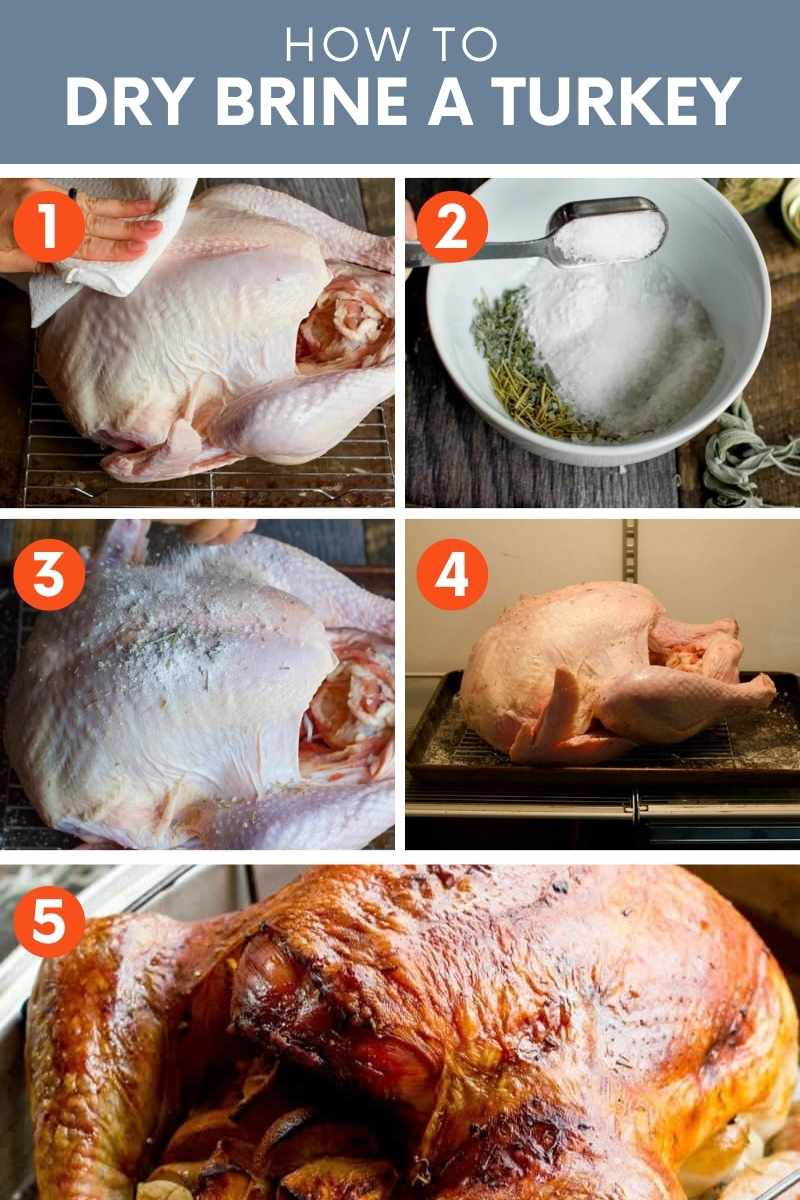
- Dry off your defrosted turkey. Take either your defrosted frozen turkey or your fresh turkey and remove the giblets (set those aside to make stock—no waste!), and then pat the turkey dry inside and out with paper towels.
- Mix up your turkey brine recipe. Mix together the brine recipe below in a small bowl.
- Sprinkle it on the bird. Sprinkle the mixture all over the turkey—inside the bird, on the breasts, on the legs and wings—everywhere! No need to rub or pat it in.
- Refrigerate. Slide that turkey onto a baking sheet and put it in the fridge uncovered. Twenty four hours will give you good results for smaller birds, but for the best flavor, you want the brine to work its magic for three days.
- Cook your turkey. Then, you’re ready to roast, fry, or smoke. Proceed with your usual recipe (we’ve included one below)—just skip any more added salt your recipe may call for. No need to wipe the brine off before roasting.
How long do you dry brine a turkey?
The rule of thumb with any turkey brine is the bigger the bird, the longer the dry brine needs to sit on it. A dry brine of 24-48 hours will do wonders on a turkey breast or smaller turkey (less than 10 pounds). Medium to large turkeys (above 10 pounds) need at least three days of brine time to see good results.
Can you dry brine a turkey in one day?
Any brine time is better than no brine time! So if it’s Wednesday before Thanksgiving, go ahead and get a dry brine on your bird—and then try to remember to start a little earlier next year.
What if I don’t have time to brine my turkey?
No worries. You’ll still have a delicious bird, it just won’t be quite as flavorful and juicy as if you were able to brine it.
Wholefully Protip
To prevent forgetting to brine your turkey next year, set a reoccurring annual reminder for the weekend before Thanksgiving on your calendar or phone to dry brine the turkey.
Now that we’ve learned all about dry brining, let’s cover turkey roasting 101. The recipe below is one that my family has used for decades! My Mama cut the original version out from a magazine way back in the 80s, and we’ve been tweaking and fine-tuning it ever since.
Whenever we have new people over for Thanksgiving, we almost always get comments that it’s the best turkey they’ve ever eaten! While this recipe in particular is for a roasted turkey, we’ve also had great success with both smoking and deep-frying a turkey. The dry brine process is the same no matter what method you use to cook.
Do you rinse off dry brine on turkey?
You don’t need to rinse the brine off of your turkey before cooking. And in fact, if you have brined long enough, you should notice the majority of the brine has been absorbed into the bird.
How do I choose the right size Thanksgiving turkey?
A good rule of thumb is buy 1 pound to 1 1/2 pounds of turkey per person. The closer you are to the 1 1/2 pounds per person mark, the more leftovers you will have. We love having turkey leftovers around for turkey soup or turkey pot pie, so we always try to hit the 1 1/2 pound per person mark!
How should I thaw a frozen turkey?
The two recommended ways are either in the fridge or in cold water. Here’s how to do both:
- To Thaw in Fridge (Slow Method): If you have space in your fridge, thaw your turkey in its packaging in there. It will take approximately 24 hours for every 5 pounds of turkey.
- To Thaw in Cold Water (Faster Method): Keep the turkey in its original wrapping and place in a vat of cold water—a cooler or bucket works well. It’ll take about 30 minutes per 5 pounds of turkey.
The slow speed of thawing is another reason why it’s often better to purchase and cook two smaller turkeys than one large bird when cooking for a crowd. A 20-pound turkey can take four or more days to thaw in the fridge! But two 10 pounders? You’re done in two days.
Can I dry brine a frozen turkey?
I personally prefer putting my turkey brine on a thawed bird, but it works perfectly fine to dry brine a fully frozen or partially frozen turkey, and then let the brining and thawing process happen at the same time.
What’s the best type of roasting pan for cooking a turkey?
I highly recommend investing in a good-quality, sturdy roasting pan. I personally have a Cuisinart Roaster Pan that I’ve used for years with good results.
Wholefully Protip
It might seem silly to invest in a pan you’ll only use once a year, but the flimsy aluminum pans are hard to work with, and a roaster will pay for itself within just a few years!
Can you stuff a dry brined turkey?
You technically can, but I don’t think you should stuff your turkey! I know this is super controversial in some families, but I am 100% in favor of an un-stuffed bird. Why? Here are my arguments in favor of dressing-on-the side:
- Stuffing acts like a giant sponge. It soaks up all the flavorful broth and juices from the bird. Which is great for the stuffing, but not so great for the bird.
- Because the stuffing is so dense, in order for it to be cooked to a safe temperature, you often have to overcook the turkey itself.
Instead, I use high-quality broth to make the dressing and cook it separately. That leaves the delicious turkey juices to keep the turkey moist and yummy, and gives me flexibility with the turkey roasting time to get the most moist turkey meat possible.
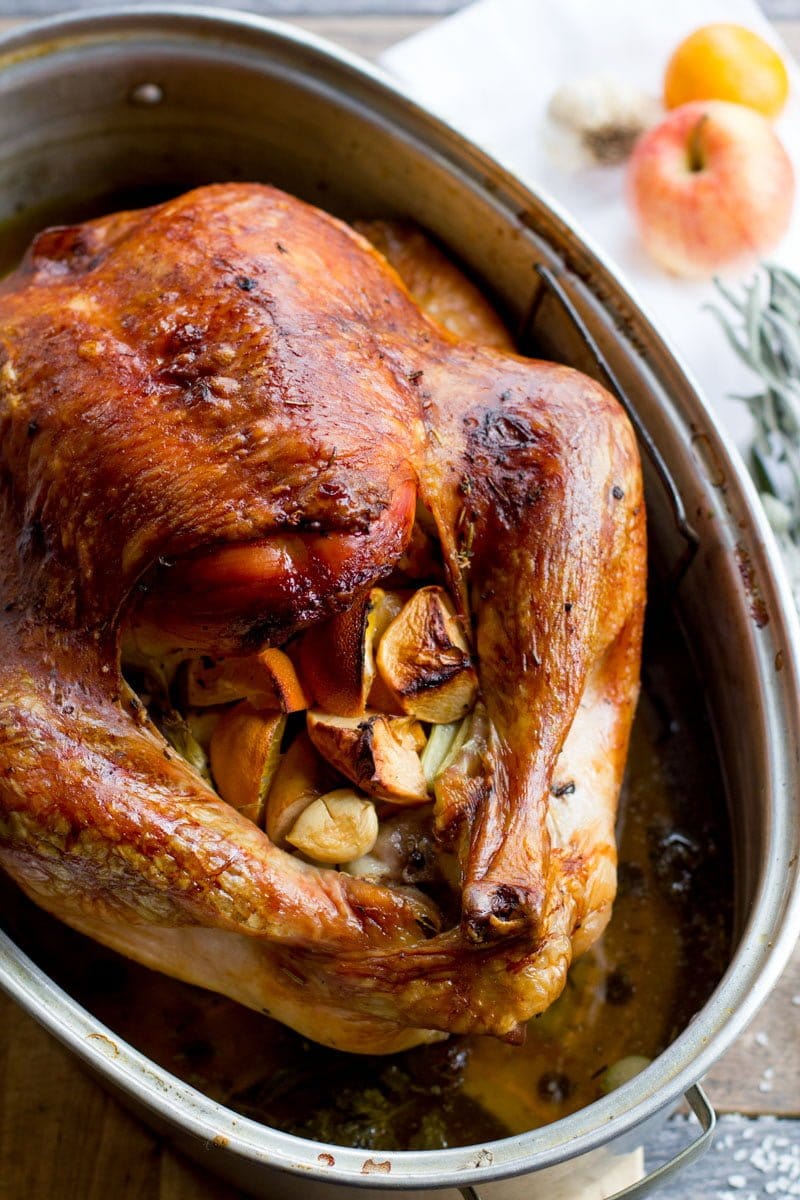
Do I need to cover a turkey with foil while it cooks?
The answer to this depends on how your turkey looks! I only use foil when it looks like my turkey is starting to get a bit too browned on top—then I’ll tent foil over it to keep it from over-browning.
How do you know when a turkey is fully cooked?
I like to make sure the turkey is done with three different methods—time, temperature, and the leg wiggle.
- Time: A rule of thumb is that the turkey needs to cook 13-15 minutes per pound in a 325°F oven. This is just a rule of thumb. It’s a good idea to set a timer when you first put in your turkey to give you a general idea of when it’ll be ready, but don’t rely on time alone.
- Temperature: You want the internal temperature of the meat (not near the bone) to reach 165°F with an instant-read thermometer, but pull it out of the oven a few degrees before that because it’ll continue cooking outside the oven. I usually pull mine out when it reaches 160°F.
- Leg wiggle: This is the final test to make sure the dark meat is cooked. I take one of the legs solidly in my hand and wiggle—the joint should feel very loose (almost like you could break it off easily).
Why all three? Well, getting a turkey to the right doneness is the most important and most finicky part of the process. And honestly? I don’t feel like any of the three methods is all that reliable on its own. I remember one Thanksgiving, the time and temp were right, but it wasn’t passing the leg wiggle test and needed to go back in the oven for a few more minutes. 15 minutes later, the turkey passed all three tests and was done perfectly.
Wholefully Protip
When you remove your turkey from the oven, tent it with foil and let it rest for at least 20 minutes before carving. This will allow the juices to redistribute through the turkey, making for more moist slices.
Now that you know how to dry brine and you have our family-tested roasted turkey recipe in your pocket, you’re going to rock cooking Thanksgiving dinner this year!
Want more reader-favorite Thanksgiving recipes like this one?
- Once you try these Crock Pot Mashed Potatoes, you’ll never go back to making them on the stove!
- This Buttery Yeast Rolls recipe is a great place to start for beginner bread bakers.
- Cooking for a small group? Try our Instant Pot Turkey Breast with Easy Turkey Gravy.
- Can you make an entire turkey day dinner on a cooking sheet? Sure can, with our Sheet Pan Thanksgiving!
- Thanksgiving Green Bean Casserole is a classic on lots of tables. Learn how to make it with fresh green beans and your own mushroom cream sauce.
- Sweet Potato Pie is a classic holiday crowd-pleasing dessert!
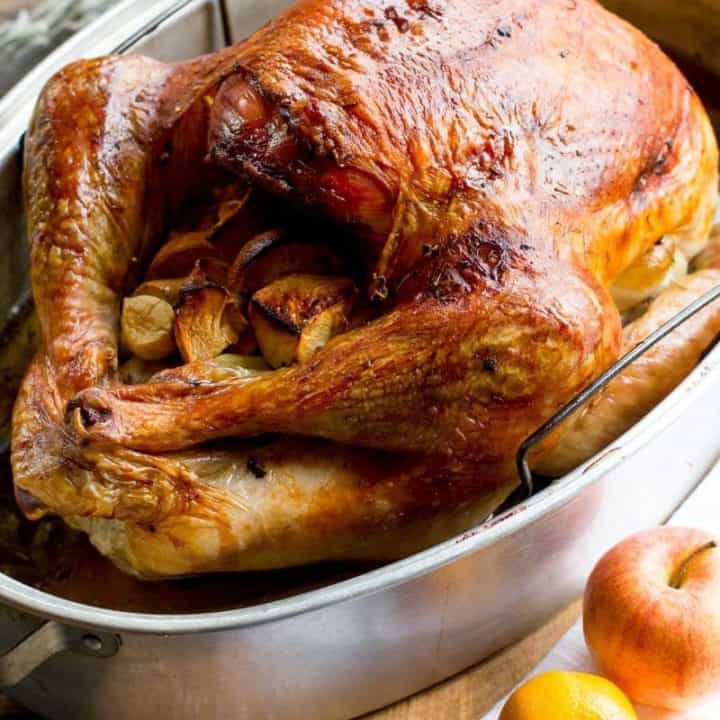
Juicy Dry Brine Turkey Recipe with Easy Turkey Gravy
Possibly the easiest and best way to cook a juicy, tender, and flavorful turkey is dry brining. Here’s how to do it right.
Ingredients
For the Dry Brine:
- 3 tablespoons coarse kosher salt
- 3 tablespoons baking powder
- 2 tablespoons dried herbs OR 1/4 cup fresh minced herbs (see notes for suggestions)
- 1 15-pound defrosted or fresh turkey (see notes for adjustments for different sizes)
For Roasting the Turkey
- 3 large carrots, roughly chopped, divided
- 3 large stalks celery, roughly chopped, divided
- 1 onion, roughly chopped
- 8 cloves garlic, peeled, divided
- 3 large sprigs each fresh sage, rosemary, and thyme
- 3 bay leaves
- 1 large apple, sliced into wedges
- 1 large orange, sliced into wedges
- 1/2 cup (1 stick) unsalted butter, cut into pats
- 5 cups chicken broth, divided
For Simple Turkey Gravy
- 3 tablespoons butter
- 2 tablespoons all-purpose flour
- Salt and pepper, to taste
Instructions
To Dry Brine the Turkey (2-3 Days in Advance of Cooking)
- Remove the giblets from the turkey and set aside for stock or gravy. Pat turkey dry with paper towels, inside and out. Place turkey on a rimmed baking sheet.
- Mix together the salt, baking powder, and herbs to make the brine.
- Sprinkle the brine all over the inside and outside of the turkey.
- Refrigerate for 24-72 hours, uncovered.
To Roast the Turkey
- Preheat oven to 325°F. In the bottom of a large roasting pan, place 2/3 of the carrots, 2/3 of the celery, all of the onion, 6 of the garlic cloves, a sprig each of sage, rosemary, and thyme, and the bay leaves. Place the roasting rack on top.
- Place the turkey on the roasting rack, breast side up. In the cavity of the turkey, place the remaining carrots, celery, garlic, sage, rosemary, and thyme. Add in the apple and orange slices. You'll really have to stuff it all in there with some force. You can choose to bind the legs closed with kitchen twine if that'll keep it all in.
- Place the butter pats either between the skin and breast of the turkey (this might be difficult with a dry brined turkey) or on top of the turkey.
- Place the turkey in the oven and roast for 45 minutes. Pour half the chicken broth over the turkey, and then roast for an additional 45 minutes. Pour the remaining chicken broth over the turkey, and roast an additional 45 minutes.
- Continue roasting, basting with juices regularly, and tenting with foil if the turkey begins to brown. Roast until the turkey reaches ~160°F on an instant-read thermometer in the fleshy part of the thighs.
- Remove from oven, tent with foil, and let rest for at least 20 minutes before carving.
To Make Easy Turkey Gravy
- While the turkey rests, strain the drippings from the roasting pan into either a large glass measuring cup or a fat separator. Let sit for a few minutes for the fat to separate from the broth. Measure out 3 cups of the broth from the drippings.
- In a medium-size saucepan, heat the butter over medium heat until melted. Whisk in the flour, and cook, stirring constantly, until just slightly browned—about 3 minutes.
- Whisk in the broth, and cook until smooth and thickened, about 5 minutes. Season to taste with salt and pepper.
- If the gravy doesn't thicken properly, whisk together 2 teaspoons arrowroot or cornstarch with 2 tablespoons of water, and then add the slurry to the mixture. Heat until it reaches the desired thickness.
- If gravy gets too thick before serving, whisk in additional broth from the turkey drippings until you get the desired thickness.
Notes
- Fresh herbs will get you the best flavor, but dried or a combination of the two work well. I like to use equal parts sage, thyme, and rosemary.
- This recipe works as-is for various size turkeys, except the brine recipe. If using a smaller or larger turkey, use this ratio per 5 pounds of turkey: 1 tablespoon kosher salt, 1 teaspoon baking powder, and 2 teaspoons dried herbs OR 2 tablespoons fresh minced herbs.
- Dry brining works best on a thawed or fresh turkey, but you can also do it on a frozen or partially-defrosted turkey with good results.
Nutrition Information:
Yield: 1 Serving Size: 1 turkeyAmount Per Serving: Calories: 1767Total Fat: 79gSaturated Fat: 36gTrans Fat: 2gUnsaturated Fat: 35gCholesterol: 626mgSodium: 29335mgCarbohydrates: 127gFiber: 23gSugar: 57gProtein: 149g
At Wholefully, we believe that good nutrition is about much more than just the numbers on the nutrition facts panel. Please use the above information as only a small part of what helps you decide what foods are nourishing for you.

